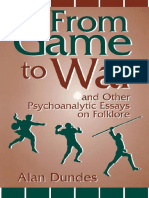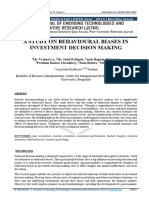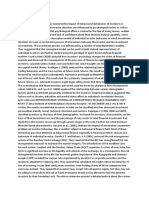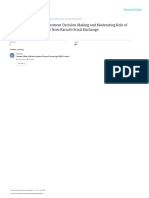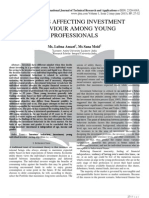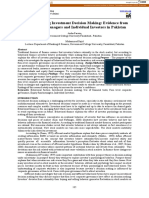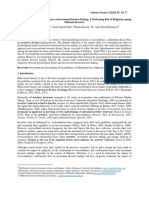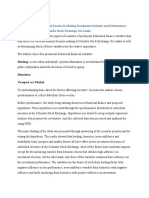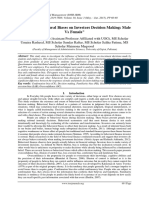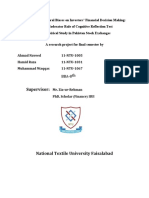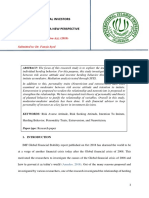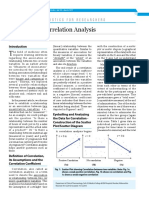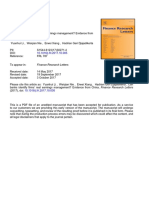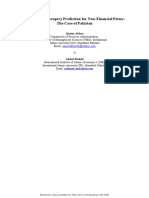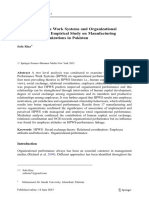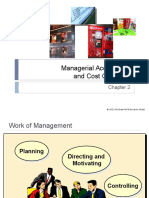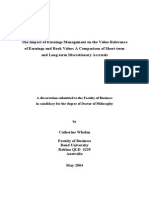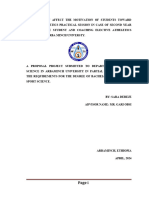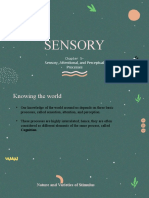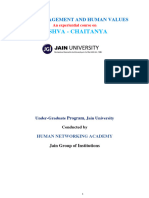Risk Perception Is A Mediator Between Heuristic Bias and Risky Investment Decision Empirical Evidence From Pakistan's Equity Markets
Risk Perception Is A Mediator Between Heuristic Bias and Risky Investment Decision Empirical Evidence From Pakistan's Equity Markets
Uploaded by
MKashifKhurshidCopyright:
Available Formats
Risk Perception Is A Mediator Between Heuristic Bias and Risky Investment Decision Empirical Evidence From Pakistan's Equity Markets
Risk Perception Is A Mediator Between Heuristic Bias and Risky Investment Decision Empirical Evidence From Pakistan's Equity Markets
Uploaded by
MKashifKhurshidOriginal Description:
Original Title
Copyright
Available Formats
Share this document
Did you find this document useful?
Is this content inappropriate?
Copyright:
Available Formats
Risk Perception Is A Mediator Between Heuristic Bias and Risky Investment Decision Empirical Evidence From Pakistan's Equity Markets
Risk Perception Is A Mediator Between Heuristic Bias and Risky Investment Decision Empirical Evidence From Pakistan's Equity Markets
Uploaded by
MKashifKhurshidCopyright:
Available Formats
Research Journal of Finance and Accounting
ISSN 2222-1697 (Paper) ISSN 2222-2847 (Online)
Vol.7, No.21, 2016
www.iiste.org
Risk Perception is a Mediator between Heuristic Bias and Risky
Investment Decision; Empirical Evidence from Pakistans Equity
Markets
Muhammad Ishfaq
Assistant Professor, Riphah International University, Faisalabad Campus
M. Kashif Khurshid
Assistant Professor, Numl University, Faisalabad Campus
Noshaba Anjum
Lecturer, Riphah International University, Faisalabad Campus
Abstract
Investors play a vital role in stock exchange. Sometimes the decisions are based on rational behavior and
sometimes these decisions consist of irrational behavior. Traditionally researchers argued that investors behave
like a rational agent. Objectives: This study explores the investors cognitive biases and how heuristic bias put
effect on investor decision. At the same time due to globalization stock market situation is changed day by day
even after few seconds. There are numerous biases which are putting effect on investor decisions but this study
explores the effect of heuristic bias on risk perception, which is mediating variable and also examined the effect
of heuristic bias on risky investment decision. Place of the Study: This study is conducted on Pakistan Stock
Exchange. Subject and Method: As this study belongs to the behavior of investor so it comprise of primary data.
For this purpose adapted questionnaire is used. 450 questionnaires are distributes out of which 400
questionnaires are returned. The data is run on SPSS. To check the reliability of questionnaire, Cronbachs alpha
is applied and the result of reliability is above than 0.7 which is considered to be fit tool for research. Results &
Conclusion: The study finds a significant relationship heuristic and and risky investment decisions. There is full
mediation between heuristic and risky investment decision while risk perception is a mediating variable. Study
also indicates that risk perception have also positive and significant relation with risky investment decisions.
Introduction
The investment in the stock market is a complex and important process for an ordinary person. Whenever a
person or an investor wants to take a decision about how, where and why to invest in the stock market, there are
several reasons which are effecting their behavior.
Nowadays a study is being used to take better decisions about the investment in the stock market. This
study is called behavioral finance. Behavioral finance show how individualinvestors interpret and judge the
information to take risky investment decisions. Behavioral finance defines the mental abilities which are about
attention, Memory, reasoning, problem solving, decision making and comprehension. In psychology cognition is
related to mind, thinking and intelligence. In simple words we can say that cognition is related to the higher
mental process such as thinking, feeling, logical ability, analytical ability, problem solving and decision making
(Shiller, 2003).
Study of behavioral finance shows the impact of psychology on the performanceand abilities of
investors and it is important to study because it shows the main factors behind market inadequacy. Investors
decisions are reflected by the cognitive errors, feelings and emotions and these behavioral actions urge a investor
to take decision. Bias is leaning of character to present a viewpoint often accompanied by rejection consider the
possible alternative view. Bias can be defines as in simple words that biases mean one sided not having an open
mind. People are biased toward individual, race and nation (Pedhazur, 1997).
The purpose of this study is to investigate those factors and biases which are effecting to investors
while they are making risky decisions. Most of the studies explore the portfolio decisions but there is a lack of
activity to investigate the biases who are effecting to risky investment decision.
Prospect theory
Kahneman and Tversky(1979) develop an alternative model which explains the risk in a different way. Prospect
theory explains that potential outcome before reaching the final outcome.
Regret theory
Regret theory also postulate the risk perception and decision making behavior of the investor according to this
theory sometimes investor wants to take risk and sometimes they avoid making investment. Both investment and
risk are related to each other. (Loomes, Graham & Robert., 1982).
Research Journal of Finance and Accounting
ISSN 2222-1697 (Paper) ISSN 2222-2847 (Online)
Vol.7, No.21, 2016
www.iiste.org
Biases
The developed market practices is positively related to emerging and diversified market .Firms' entry and
survival in developed markets are features that are same in both the markets. However, cognitive biases are the
biases that directly linked with the roles that are being played by other type of experience and knowledge
(Shefrin, 2002).
Heuristic
The concept of uncertainty and risk always go hand in hand. According to Kahneman, and Tversky (1979)
heuristic judgment constitutes the only practical way to evaluate uncertain elements.
Risky investment
Shah(2008)the subjective judgment and thinking of customer and market situation is not only affected to investor
but it also affect to company.
Risk perception
Risk perception determines investorsopinion when they evaluate pervious or how risk is associated with
investment (Slovic,1987). Thus investors opinion is totally linked the risk perception they possess.
Risky investment decision
A study is conducted by at South Korea in field experiment to evaluate that how stock prices influence investors
trading decisions and investment performance. Questionnaire is distributed to 550 respondents. Such kind of
investor has higher expectations about stock prices and they trade frequently but get lower realized
returns.Researcher argued and concluded that heuristic bias and perceived competences of investors,
subsequently effects investors trading patterns, frequency and performance.
Iqbal (2014) conducted a study in Karachi and sukkhar in Questionnaires are distributed to collect the
data. 250 questionnaires were distributed to investors out of which 178 were considered as worth full. Data was
analyzed through one sample t-test and Pearson correlation coefficient techniques to check the relationship
between the variables.Results show that the most of biases are significant and they have positive relationship
with market development and decision making.
Objectives of the study
To discover the effect of Heuristic bias on risky investment decision.
Effect of risk perception as a mediating variable between heuristic bias and risky investment decision.
Significance of the study
In the present study we can say that factor that effect on decision making by individual investors is usually based
on their age, education, income, investment portfolio, and other demographic factors. The impact of behavioral
and cognitive biases aspect on risky decision making specially ignored. The objective of this paper is to explore
the impact of behavioral factors and investors psychology on their decision-making, and to examine the risk
perception as mediator effect on decision making.
Academic significance
Practically, this study is also worthwhile for Business Administration students. Most of investors have lack of
business education. They put money in risky investment just on the bases of their experience. Due to lack of
business education they have not an idea of what is the basic reason behind that why share prices are reflected or
fluctuated. Majority of investors rely on financial analyst who have chartered accountant and CFA analyst.
Multinational companies hire those business students who have analyst and know the knowledge behind the
fluctuation of prices. Business students perceive the risk in a better way as compared to those who are not
qualified. They can observe that how various biases influence on share prices and how risk perception effect the
decision making of an investor.
Conceptual Framework
Theoretical Framework depicts the cause and effect relationship between heuristic bias and risky
Research Journal of Finance and Accounting
ISSN 2222-1697 (Paper) ISSN 2222-2847 (Online)
Vol.7, No.21, 2016
www.iiste.org
investment decision while risk perception playing as a mediating variable.
Hypotheses of the Study
H1: There is a significant relationship between Heuristic and risky investment decision.
H2: There is a significant relationship between risk perception and risky investment decision.
H3: Risk perception is a mediator between heuristic bias and risky decision making.
Research Design and Methodology
This study is based on primary data. Questionnaires are personally handed over to the respondents for getting
their responses. These respondents are individual investors who have interest to make investment in Pakistan
stock exchange. The technique which is used in the present study is random sampling technique. Sobel test is
applied to check the mediating effect of risk perception and also check direct and indirect effect of variables on
risky investment decisions.
Population and Sample
The population of this survey is investors which belongs Pakistan stock exchange. There are more than 1200
companies registered in Pakistan stock exchange and also existing number of brokerage houses who are
providing the facilities to investors to make investment in different stock exchanges.
Results:
Mediating Effect
Preacher and Hayes (2004) use SPSS Macro for Simple mediation. In this study, sobel test is used to check the
mediating and cognitive biases affect on risky investment decisions. Sobel test is also worthwhile for direct and
indirect effect.
Variables in simple mediation model
Y
Risky investment decision (RID)
X
Heuristic bias (HB)
M
Risk Perception (RP)
Risky investment decision is dependent variable and heuristic bias is independent variable while risk perception
is dependent variable.
Table
Direct and total effects
Coeffs.e.t
Significance(two)
1. b(YX)
.3768 .0437 8.6260 .0000
2. b(MX)
.4216 .0405 10.4173 .0000
3. b(YM.X) .9797 .0227 43.1148 .0000
4. b(YX.M) -.0363 .0207 -1.7525 .0805
There is a significant relationship between heuristic bias and risky investment decision as sig value is
less than 5%. Value of coefficients (0.3768) depicts the value of risky investment decision as there is unit change
in heuristic bias. There is a significant relationship between heuristic and risk perception.
Indirect and significanceusing normal distribution
Value
s.e. LL95CI UL95CI Z Significance (two)
Effect .4131 .0408 .3331 .4931 10.1234 .0000
To check the mediating effect firstly considers the indirect effect. Significance value is less than 5% so
it means there is a significance relationship between risk perception and risky investment decision. Secondly
0.0805 value shows that there is insignificant relationship so it means that there is full mediation effect. Due to
insignificant relationship coefficient value (-0.0363) is ignored.
Variables in simple mediation model
Y (Dependent variable) Risky investment decision (RID)
X (Independent variable) Heuristic Bias
M (Mediating)
Risk Perception (RP)
Table
Directs and Total effects
Coeffs.e.t
Significance (two)
1.
b(YX)
.7505 .0438 17.1404 .0000
2.
b(MX)
.8482 .0355 23.8995 .0000
3.
b(YM.X) 1.0711 .0307 34.8577 .0000
4.
b(YX.M) -.1580 .0339 -4.6539 .0000
Firstly check the effect of heuristic biases on risky investment decision. Result shows that there is
significant relationship between heuristic bias and risky investment decision as the sig value is less than 5%.
Risky perception is a mediating variable. Thirdly check the effect of risk perception (mediating
variable) on risky investment decision as bias is controlled variable. There is a significant relationship between
Research Journal of Finance and Accounting
ISSN 2222-1697 (Paper) ISSN 2222-2847 (Online)
Vol.7, No.21, 2016
www.iiste.org
risk perception and risky investment decision.
Value of unstandardized (0.750) depicts the value of risky investment decision if there is one unit change in
heuristic bias.
Indirect and significanceusing normal distribution
Value
s.e. LL95CI UL95CI
Z Significance (two)
Effect .9085 .0461 .8181 .9988 19.7059 .0000
Conclusion
Investors while taking investment decisions must consider these biases as risk factor associated with their
investment portfolios. So there is a need to understand, utilization and interpret of these two biases This research
will help them to judge investors attitudes towards risk with a new perspective, and in a better way, thus leading
to better investment decision making.The present study is also helpful for investors to aware about the
consequences of their demographic roles and behaviors regarding risky investments thathow business tenure
effecting to their investment decisions. Understanding of the cognitive biasesplaying vital role, especially when
there is prevailing uncertainty in the market. The current study will increase the confidence of individual
investors to prefer risky investments by providing them guidance that how to control the constraint
factors to achieve higher returns and secure their capital. Emotional and personality factors need to be
incorporated in the investment strategies formulated for individual investors.
Findings and limitations
It is common human tendency to make investment decision which give huge returns and safe investment.
Previous studies concluded that traditionally an investor decisions are based on rational. Only market forces and
factors affecting and influence to investors to take decisions. Behavioral finance advances the concept that
investors perception is based on some psychological thinking and beliefs. Investors decisions are not based on
the market situation and forces.
There are several other biases which are affecting to investment. Some biases are relates to own mental
capabilities and some relates to thinking level of an investors. It is difficult to access and know the each and
every investor behavior because behavioral finance is based on the personal observations and thinking and
decisions made by the investors depends on the biases.
References
Iqbal (2014).Determinants of Retail Investors Behavior and its impact on investment decision, International
Letter of Social and Humanistic Sciences 7, 31-43.
Kahneman, D. &Tversky, A. (1979) Prospect theory: An analysis of decision under risk, Econometrica, (47) 263
291.
Loomes, Graham & Robert (1982).Regret theory: An alternative theory of rational choice under uncertainty,
Economic Journal 92, 80524.
Preacher, K. J., & Hayes, A. F.(2004). SPSS and SAS procedures for estimating indirect effect in simple
mediation models. Behavior Research Methods, 2004, 36 (4), 717-731
Pedhazur, E. J., (1997). Multiple Regression in Behavioral Research (3rd ed.). Orlando, FL:Harcourt Brace.
Shah, A., & Oppenheimer, D. (2008). Heuristics made easy: an effort reduction framework, Psychological
Bulletin, 134(2), 207-222.
Shefrin,H.(2002) Behavioral decision making, forecasting, game theory, and role-play. International Journal of
Forecasting 18, 375382
Shiller R. 2003. From Efficient Markets Theory to Behavioral Finance, The journal of Economic
perspectives,(17),83-104.
Slovic, P. (1987), Perception of Risk. Science, 236(4779),280285.
Thaler & Richard J., (1999). Mental Accounting Matters, Journal of Behavioral Decision Making (12), 183206.
Tseng, S., & Yang, C. (2011). The role of information searches in investment choice variation: Digital
information, advice seeking and heuristics, African Journal of Business Management 5 (12),
4934-4944.
Tversky, A., & Kahneman, D. (1986). Rational choice and the framing of decisions. Journal of Sbusiness, 251278.
Tversky, A., & Kahneman, D. (1992). Advances in prospect theory: Cumulative representation of uncertainty.
Journal of Risk and uncertainty,297-323.
10
You might also like
- Raw TranscriptionDocument2 pagesRaw TranscriptionBrigette Domingo58% (12)
- Fab Sweets Limited CaseDocument4 pagesFab Sweets Limited CaseKha LidNo ratings yet
- Alyaa Natasha Section69 - Mind MapDocument9 pagesAlyaa Natasha Section69 - Mind MapALYAA NATASHA (BG)No ratings yet
- Behavioral Biases in Investment Decision Making and Moderating Role of Investors TypeDocument24 pagesBehavioral Biases in Investment Decision Making and Moderating Role of Investors TypeAlvin ZhayyanNo ratings yet
- Dundes, Alan - From Game To War and Other Psychoanalytic Essays On Folklore.-Univ PR of Kentucky (2014) PDFDocument140 pagesDundes, Alan - From Game To War and Other Psychoanalytic Essays On Folklore.-Univ PR of Kentucky (2014) PDFNicolás Toler100% (1)
- Moral and Non-Moral StandardsDocument11 pagesMoral and Non-Moral StandardsSiza Sorupia100% (1)
- 1684-Article Text-6733-1-10-20220416Document12 pages1684-Article Text-6733-1-10-20220416Salman KhanNo ratings yet
- My Research PaperDocument17 pagesMy Research Papersmtceo146No ratings yet
- Behavioral Biases in Investment Decision MakingDocument24 pagesBehavioral Biases in Investment Decision MakingERika PratiwiNo ratings yet
- Hayat 2016 Invesment DecisionDocument14 pagesHayat 2016 Invesment DecisionNyoman RiyoNo ratings yet
- BF Kerala Q 7Document21 pagesBF Kerala Q 7SarikaNo ratings yet
- UntitledDocument44 pagesUntitledSkCharumathiNo ratings yet
- Open JETIR2403A14 17Document14 pagesOpen JETIR2403A14 17y88qgss7dkNo ratings yet
- (Draft) Lit ReviewDocument16 pages(Draft) Lit ReviewHoang OanhNo ratings yet
- Final Report - Plag (Revised)Document39 pagesFinal Report - Plag (Revised)Rachna KathuriaNo ratings yet
- Devansh Gupta - FinanceDocument39 pagesDevansh Gupta - FinanceRachna KathuriaNo ratings yet
- 030 - Investment Decision MakingDocument9 pages030 - Investment Decision MakingSwami PranaNo ratings yet
- Overconfidence and Investment Decisions in Nepalese Stock MarketDocument10 pagesOverconfidence and Investment Decisions in Nepalese Stock MarketMgc RyustailbNo ratings yet
- Impact of Conservatism Bias Effect On Investment Decisions of Pakistani Stock InvestorDocument13 pagesImpact of Conservatism Bias Effect On Investment Decisions of Pakistani Stock InvestorHassan RazaNo ratings yet
- Measuring Validity of Determinants of Individual Investor DecisionDocument6 pagesMeasuring Validity of Determinants of Individual Investor Decisionqamar.abbasNo ratings yet
- Review of LiteratureDocument6 pagesReview of LiteratureAkhil AnilkumarNo ratings yet
- MPRA Paper 53849Document8 pagesMPRA Paper 53849Vipul GhoghariNo ratings yet
- An Analysis of Behavioral Biases in Investment Decision-MakingDocument13 pagesAn Analysis of Behavioral Biases in Investment Decision-MakingZubaria BashirNo ratings yet
- The Determinants of Invesment Decision Making BehaviourDocument4 pagesThe Determinants of Invesment Decision Making BehaviourAbdul LathifNo ratings yet
- Behavioralpaper PDFDocument25 pagesBehavioralpaper PDFNadeemNo ratings yet
- Behavioralpaper PDFDocument25 pagesBehavioralpaper PDFNadeemNo ratings yet
- Behavioralpaper PDFDocument25 pagesBehavioralpaper PDFNadeemNo ratings yet
- Factors Affecting Investment Behaviour Among Young ProfessionalsDocument6 pagesFactors Affecting Investment Behaviour Among Young ProfessionalsInternational Jpurnal Of Technical Research And ApplicationsNo ratings yet
- Investor Attitudes and Behavior Towards Inherent Risk and Potential ReturnsDocument13 pagesInvestor Attitudes and Behavior Towards Inherent Risk and Potential ReturnsMJaya19No ratings yet
- Jurnal Ekonomi: Nur Asfira, Andewi Rokhmawati, Ahmad Fauzan FathoniDocument13 pagesJurnal Ekonomi: Nur Asfira, Andewi Rokhmawati, Ahmad Fauzan FathonilaluaNo ratings yet
- UnfurledDocument8 pagesUnfurledsowyam saleNo ratings yet
- Bahvioral FinanceDocument14 pagesBahvioral FinanceNouman MujahidNo ratings yet
- Behavioural Finance ProposalDocument4 pagesBehavioural Finance ProposalVansh Bathla B-004No ratings yet
- IJMRES 7 Paper Vol 8 No1 2018Document8 pagesIJMRES 7 Paper Vol 8 No1 2018International Journal of Management Research and Emerging SciencesNo ratings yet
- 17 (Adil Mehraj)Document8 pages17 (Adil Mehraj)Sakshi AgarwalNo ratings yet
- A Study of Investor Behavior and PsycholDocument6 pagesA Study of Investor Behavior and Psycholanuragigovinda60No ratings yet
- Research Based LearningDocument12 pagesResearch Based Learningfxaditya112233No ratings yet
- Determinants - of - Individual - Investor - Beha - Rated 3 JournalDocument9 pagesDeterminants - of - Individual - Investor - Beha - Rated 3 JournalSimaNo ratings yet
- The Influence of Behavioral Factors in Making Investment Decisions and Performance: Study On Investors of Colombo Stock Exchange, Sri LankaDocument2 pagesThe Influence of Behavioral Factors in Making Investment Decisions and Performance: Study On Investors of Colombo Stock Exchange, Sri LankaFikir GebregziabherNo ratings yet
- Jurnal FramingDocument16 pagesJurnal FramingLita RianNo ratings yet
- Relevance of Behavioural Finance in InvDocument3 pagesRelevance of Behavioural Finance in Invnaeemah977No ratings yet
- A Comparative Study On Investment Practices of Individual Investors in Dhaka and Chittagong Stock MarketDocument13 pagesA Comparative Study On Investment Practices of Individual Investors in Dhaka and Chittagong Stock Marketmdfahimshahriar09No ratings yet
- Behavioral Finance: Investors Psychology Nuel Chinedu Ani Çiğdem ÖzarıDocument11 pagesBehavioral Finance: Investors Psychology Nuel Chinedu Ani Çiğdem ÖzarıOptimAds DigMarkNo ratings yet
- Befi - Rasheed PDFDocument9 pagesBefi - Rasheed PDFRenuka SharmaNo ratings yet
- Behavioral Biases and Investment Decision MakingDocument52 pagesBehavioral Biases and Investment Decision MakingAhmad NaveedNo ratings yet
- International Institution For Special Education Lucknow: CaseletDocument9 pagesInternational Institution For Special Education Lucknow: Caseletsaurabh dixitNo ratings yet
- Individual Investors Herding Behavior A New PerspectiveDocument20 pagesIndividual Investors Herding Behavior A New PerspectiveHina MasoodNo ratings yet
- A Study On Relevance of Behavioural Finance Theories On Investor Decision MakingDocument8 pagesA Study On Relevance of Behavioural Finance Theories On Investor Decision MakingAdesh DhakaneNo ratings yet
- The Factors That Affects The Investment Behavior (PPT c1)Document24 pagesThe Factors That Affects The Investment Behavior (PPT c1)Jiezle JavierNo ratings yet
- ProposalDocument8 pagesProposalAsif AliNo ratings yet
- Research Paper 2Document7 pagesResearch Paper 2soumitra2377No ratings yet
- Ijst 2023 2845Document9 pagesIjst 2023 2845dattavi98thakerNo ratings yet
- Decision-Making in The Stock Market: Incorporating Psychology With FinanceDocument28 pagesDecision-Making in The Stock Market: Incorporating Psychology With FinanceEmiliyana SoejitnoNo ratings yet
- Behavioral Biases in Investment Decision Making: A Literature ReviewDocument7 pagesBehavioral Biases in Investment Decision Making: A Literature ReviewrajaniNo ratings yet
- A Study On Attitudinal Behaviour of Active Market Participants Towards Selection of Portfolio in Karur, TamilnaduDocument14 pagesA Study On Attitudinal Behaviour of Active Market Participants Towards Selection of Portfolio in Karur, Tamilnadubaby0310No ratings yet
- Influence of Behavioual Bias On Investment Decisions of Individual Investors in Delhi NCRDocument11 pagesInfluence of Behavioual Bias On Investment Decisions of Individual Investors in Delhi NCRDS ReishenNo ratings yet
- Behavioral Biases Across The Stock Market Investors: Evidence From PakistanDocument25 pagesBehavioral Biases Across The Stock Market Investors: Evidence From PakistanPeterNo ratings yet
- Second PaperDocument22 pagesSecond PaperADINo ratings yet
- A Study On Factors Influencing Buying Behavior of Securities in Indian Stock MarketsDocument9 pagesA Study On Factors Influencing Buying Behavior of Securities in Indian Stock MarketsShivam Singh RajputNo ratings yet
- Factors Influencing Investment Decisions of Nepalese InvestorsDocument16 pagesFactors Influencing Investment Decisions of Nepalese InvestorsHappyGautamNo ratings yet
- Financial Literacy PaperDocument33 pagesFinancial Literacy Papersufaid aliNo ratings yet
- 13-Paper Rafay's Paper DR Shafiqurrehman Required Final Paper - Revised 137-162Document26 pages13-Paper Rafay's Paper DR Shafiqurrehman Required Final Paper - Revised 137-162anuNo ratings yet
- A Study of Factors Affecting Investment Decisions: With Special Reference To Spiritual Intelligence AuthorsDocument10 pagesA Study of Factors Affecting Investment Decisions: With Special Reference To Spiritual Intelligence Authorssowyam saleNo ratings yet
- Investors and Markets: Portfolio Choices, Asset Prices, and Investment AdviceFrom EverandInvestors and Markets: Portfolio Choices, Asset Prices, and Investment AdviceRating: 3.5 out of 5 stars3.5/5 (6)
- Behavioral Finance How Psychological Factors can Influence the Stock MarketFrom EverandBehavioral Finance How Psychological Factors can Influence the Stock MarketRating: 5 out of 5 stars5/5 (1)
- Principles of Correlation Analysis: Statistics For ResearchersDocument4 pagesPrinciples of Correlation Analysis: Statistics For ResearchersMKashifKhurshid100% (1)
- 2018 12 10 AIC 2018 After ConferenceDocument194 pages2018 12 10 AIC 2018 After ConferenceMKashifKhurshid100% (1)
- Founder-Controlled Firms and R&D Investments: New Evidence From CanadaDocument21 pagesFounder-Controlled Firms and R&D Investments: New Evidence From CanadaMKashifKhurshidNo ratings yet
- Li 2017Document19 pagesLi 2017MKashifKhurshidNo ratings yet
- The Impact of Development of Insurance Market and Economy On The Competitiveness of The Country On Example of V4 CountriesDocument5 pagesThe Impact of Development of Insurance Market and Economy On The Competitiveness of The Country On Example of V4 CountriesMKashifKhurshidNo ratings yet
- Joaebrjune2018 68 92Document25 pagesJoaebrjune2018 68 92MKashifKhurshidNo ratings yet
- Modeling Bankruptcy Prediction For Non-Financial Firms: The Case of PakistanDocument27 pagesModeling Bankruptcy Prediction For Non-Financial Firms: The Case of PakistanMKashifKhurshidNo ratings yet
- Riaz 2015Document22 pagesRiaz 2015MKashifKhurshidNo ratings yet
- 1 s2.0 S2212827115001559 MainDocument6 pages1 s2.0 S2212827115001559 MainMKashifKhurshidNo ratings yet
- Kelompok 1 Metode Harga Pokok VariabelDocument79 pagesKelompok 1 Metode Harga Pokok VariabelIrma SuryaniNo ratings yet
- Chap 002Document85 pagesChap 002MKashifKhurshid0% (1)
- 02 WholeDocument158 pages02 WholeMKashifKhurshidNo ratings yet
- Epstein - Who Speaks - Discourse, The Subject and The Study of Identity in International PoliticsDocument25 pagesEpstein - Who Speaks - Discourse, The Subject and The Study of Identity in International PoliticsRonn BautistaNo ratings yet
- The Essence by Michael BrownDocument59 pagesThe Essence by Michael BrownBilalNo ratings yet
- Peer PressureDocument4 pagesPeer PressureCHIN XUN JIE MoeNo ratings yet
- MGNT 4510 China Business: - Spring 2019 - Dr. Wendong Li - Feb. 27/28, 2019Document20 pagesMGNT 4510 China Business: - Spring 2019 - Dr. Wendong Li - Feb. 27/28, 2019Leung Shing HeiNo ratings yet
- Senior High School Lesson PlanDocument2 pagesSenior High School Lesson PlanHELEN JANE A. GONo ratings yet
- PSY1011 Week 1+2 Lecture Notes Science & History of PsychologyDocument10 pagesPSY1011 Week 1+2 Lecture Notes Science & History of PsychologyCharlieFAYNo ratings yet
- Proposal For SaraDocument21 pagesProposal For SaraTsegaye YalewNo ratings yet
- Biological Theory of CriminologyDocument8 pagesBiological Theory of CriminologyMd Sumon MollahNo ratings yet
- 360 Gradusiin ArgaDocument6 pages360 Gradusiin ArgaBayarchimeg AnkhbayarNo ratings yet
- PsychologyDocument8 pagesPsychologyNikhil JosephNo ratings yet
- Francis Jay N. EnriquezDocument41 pagesFrancis Jay N. EnriquezFrancis Jay EnriquezNo ratings yet
- Immediate Download 45 Techniques Every Counselor Should Know Bradley T. Erford Ebooks 2024Document49 pagesImmediate Download 45 Techniques Every Counselor Should Know Bradley T. Erford Ebooks 2024alpyzairulNo ratings yet
- Interior Design Room Color Scheme LessonDocument3 pagesInterior Design Room Color Scheme Lessonapi-208358319No ratings yet
- Concept-Attainment ModelDocument26 pagesConcept-Attainment ModelAzimi Azmin100% (2)
- Lackof Parental Support 26Document14 pagesLackof Parental Support 26Airin NatasyaNo ratings yet
- COURSE PLAN 1 Semester PsychologyDocument20 pagesCOURSE PLAN 1 Semester Psychologyjitendra singhNo ratings yet
- Industrial Design and Human FactorsDocument13 pagesIndustrial Design and Human FactorsLokesh ReddyNo ratings yet
- Impact of VUCA World On Children's Emotional Development During Online LearningDocument8 pagesImpact of VUCA World On Children's Emotional Development During Online LearningIJPHSNo ratings yet
- Relationship Between MBTI and Career Success - Yu 2011Document6 pagesRelationship Between MBTI and Career Success - Yu 2011alanwilNo ratings yet
- Results of Implementing Communicative Language Teaching Method in English Language Learning in 9-Year Elementary Schools. (Albanian Context)Document9 pagesResults of Implementing Communicative Language Teaching Method in English Language Learning in 9-Year Elementary Schools. (Albanian Context)Francklin Nim'sNo ratings yet
- Strategic Director Human Resources in San Diego CA Reno NV Resume Julie HornDocument2 pagesStrategic Director Human Resources in San Diego CA Reno NV Resume Julie HornJulieHorn1No ratings yet
- Key 2 Day1Document7 pagesKey 2 Day1stillaphenomenon100% (1)
- Conflict and NegotiationDocument24 pagesConflict and Negotiationglendy guilaranNo ratings yet
- The Law of Success in Sixteen Lessons by Napoleon HillDocument1 pageThe Law of Success in Sixteen Lessons by Napoleon Hill杨文博No ratings yet
- Vishva - Chaitanya: Mind Management and Human ValuesDocument45 pagesVishva - Chaitanya: Mind Management and Human Valuesowais8694No ratings yet




